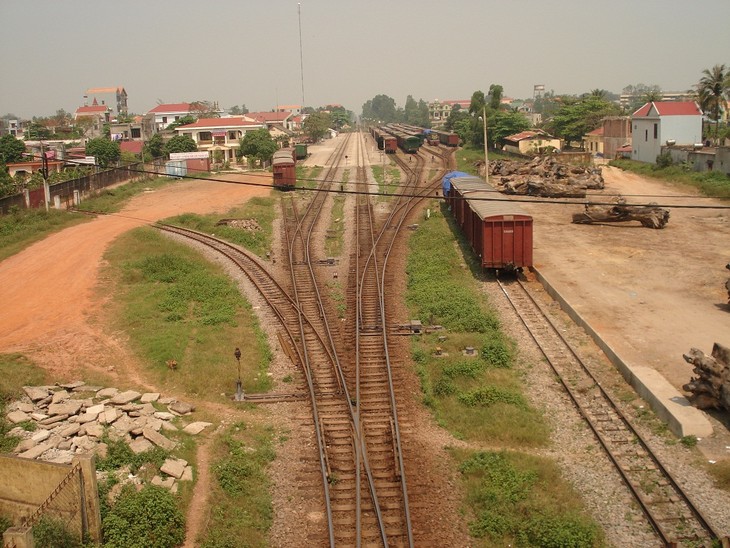A: Welcome to VOV’s Letter Box. This feature airs every Wednesday. This week, we’ve received a lot of emails and letters from Asian listeners. One is Ms. Robina Aktar, an editor with the LOLONA Listeners Club in Bangladesh. Robina told us that although it’s now the rainy season there, the club will try to hold a DX exhibition in the middle of next month.
B: We’re glad to hear you intend to offer a venue where shortwave lovers can get together and share their experiences. We wish your exhibition great success.
A: Regarding your request to send you something like a New Year’s Calendar, pins, pens or language books, we promise to send you as much as we can.
B: Robina asked about rail way stations in Vietnam. Our railway system is operated by the state-owned Vietnam Railways. The principal route is the thousand-mile single track North-South Railway line which runs between Hanoi and Ho Chi Minh City.
A: This was built in the 1880s during French colonial rule. There are also standard gauge lines running from Hanoi to China, eventually leading to Beijing, and some mixed gauge in and around Hanoi. In 2008, Ho Chi Minh City approved construction of a subway rail system, comprising four lines, the first due to be completed next year.
B: Of course, you can learn more about Vietnam’s railway system and transport by sending us specific questions. Anything we can’t answer, we’ll forward to a relevant agency so they can try. We hope you’ll keep in touch and continue to enjoy our broadcasts.
 |
| Panorama of Dong Hoi Railway Station in Quang Binh province, one of the biggest stations in Vietnam's central region. |
A: Indian listener Ratan Kumar Paul, who listened to our English program on June 17th on a frequency of 9550 Khz, wrote ‘I enjoy your world news but more enjoy cultural events’. He took the National Radio Festival as an example, which he called a ‘very beautiful program’.
B: Dear Ratan, this year’s National Radio Festival, was special for the members of the English section because we won the second prize for a live broadcast program. The biannual festival provides opportunities for broadcasters to share their experiences and professional skills, learn more about modern communication technology around the world, and honor outstanding radio broadcasters and products.
A: Ratan, if you want to know more about the National Radio Festival, please log onto our website at www.vovworld.vn and click on ‘About us’. You’ll see detailed information about the festival and competition, hear the full audio version, and enjoy some pictures of the event. Once again our website address is www.vovworld.vn.
B: One more thing we’d like to mention to Ratan is that we won’t forget you asked for a QSL card and some Vietnamese postage stamps. We’ll send them, but don’t be surprised if they arrive a bit late. Sometimes, they can get stuck somewhere on the way to you.
A: Toshiya Nishimura of Japan sent us a detailed email describing a broadcast he heard on June 5th at 13.30 UTC. He gave his impressions of the program, mentioning that the signal on 9840 Khz was not good and noise was a problem for a while ……..
B. Thank you, Toshiya, for your comments. We believe your information will be useful to our technical department. We hope they will do something so that next time you can enjoy a better signal.
A: Let us assure you that we always try to send our listeners verification cards as soon as possible. And we agree that QSLs ‘serve as a nice remembrance of contact with the stations’ you hear.
B: Here’s a letter from another Asian listener - Timm Breyel from Malaysia. Tim wrote that he particularly loves listening to Vietnam’s traditional folk songs. It’s encouraging to him to learn what Vietnam has done to preserve this aspect of its culture’.
A: Many VoV listeners have shown an interest in Vietnamese folk music. We want to say something about our country’s efforts to preserve its traditional music, but first, sit back and enjoy a folk song from Vietnam’s central region.
B: That was a Lý melody called Mynah folk sung in the style of the central province of Quang Nam. Lý singing is popular in all three regions of Vietnam - north, center and south – but Ly songs show regional variations.
A: Lý developed from children's songs and evolved into Hue singing – the distinctive performance art of Thua Thien Hue - Cheo or popular theatre, and Cai Luong or reformed theatre. Like most other kinds of folk singing in the Red River Delta, Northern Lý songs don’t have the word ‘Lý’ at the beginning of their titles. Ly singing, in fact, is much more developed in the center and the south, where it has become a stylized type of folk singing with many well-known tunes.
B: Vietnam still has many kinds of folk music and has realized the need to preserve, develop, and treasure them as icons of national character to show to the outside world. The Vietnamese Government and people have joined hands in this effort. The Government has encouraged public involvement in preserving the art forms and passing them on and is promoting the teaching of folk music in schools.
A: That’s it for today’s Letter Box. If your names wasn’t mentioned this week, don’t feel bad. We promise to acknowledge you next time. Please keep in touch with us. We look forward to receiving your comments and suggestions. Our contact address is:
The English program,
Overseas Service, Radio Voice of Vietnam,
45 Ba Trieu Street, Hanoi, Vietnam
B: Or you can email us at: englishsection@vov.org.vn. And if you miss any of our programs, you can always catch up by logging onto our website at: www.vovworld.vn, where you can hear both live broadcasts and previously recorded programs.
A&B: Bye!!!!!!